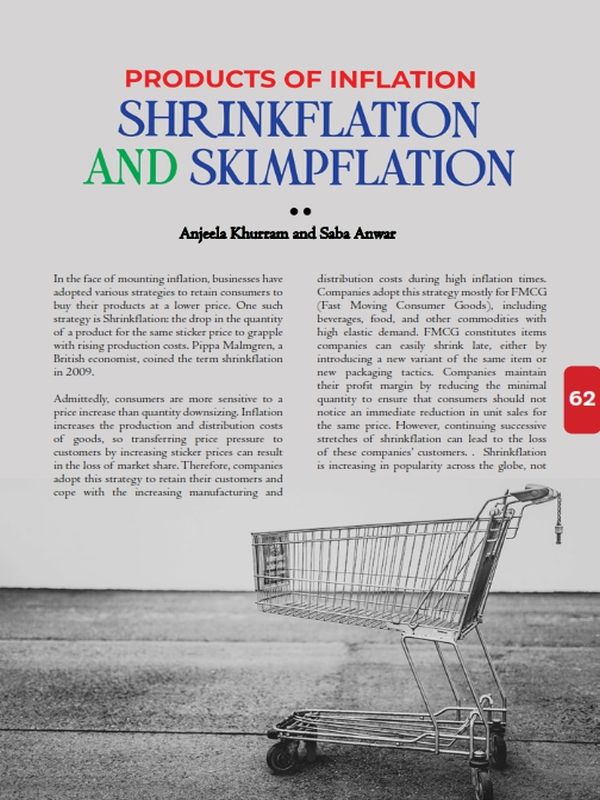Products of Inflation: Shrinkflation and Skimpflation
In the face of mounting inflation, businesses have adopted various strategies to retain consumers to buy their products at a lower price. One such strategy is Shrinkflation: the drop in the quantity of a product for the same sticker price to grapple with rising production costs. Pippa Malmgren, a British economist, coined the term shrinkflation in 2009.
Admittedly, consumers are more sensitive to a price increase than quantity downsizing. Inflation increases the production and distribution costs of goods, so transferring price pressure to customers by increasing sticker prices can result in the loss of market share. Therefore, companies adopt this strategy to retain their customers and cope with the increasing manufacturing and distribution costs during high inflation times. Companies adopt this strategy mostly for FMCG (Fast Moving Consumer Goods), including beverages, food, and other commodities with high elastic demand. FMCG constitutes items companies can easily shrink late, either by introducing a new variant of the same item or new packaging tactics. Companies maintain their profit margin by reducing the minimal quantity to ensure that consumers should not notice an immediate reduction in unit sales for the same price. However, continuing successive stretches of shrinkflation can lead to the loss of these companies’ customers.[1]. Shrinkflation is increasing in popularity across the globe, not only in Pakistan, as inflation gains momenetum. Termed as down switching by the business community in developing countries, it is a modus operandi in the rural areas only where consumers are more price sensitive. Inflation has always been known as an erosion of purchasing power, while shrinkflation is the deterioration of the quantity and quality of products.
Akin to shrinkflation, there is another phenomenon, skimpflation—when service companies shrink their services and offerings for the same price paid. NPR’s Planet Money proposed this term[2] in October 2021 to signify the deterioration in the quality of services and offerings of service industries, while the price is kept constant.
Now the question is how the combination of inflation and shrinkflation affects consumer behavior. For shorter periods while it is still unobservable, the operating profits of the businesses can soar exponentially despite the rising cost pressure, as was observed in PepsiCo and Cadbury in 201[3]. However, the continuation for longer periods can have different implications on consumer behavior. In this era of a digital revolution, smart consumers share information through social media groups, thus driving the attention of the masses toward shrinkflation. There are different modes of social media content like websites, blogs, and short videos that contain information on the downsized products along with their pictures[4]. Opined as stealth inflation and financial fraud, smart consumers start looking for the best alternatives, resulting in losing loyal brand customers. This is more prevalent in competitive markets. Also, the modified shopping habits evolve with more business turnover during “sale” and “deal” announcements.
The interesting fact is that as the bout of inflation smoothens out, the reverse is seldom observed. [5] The ‘upsizing’ doesn’t come naturally and is generally rare. The inflation expectation theory and profit margins might continue dominating board meetings’ major decision-making, yet the upsizing should be ensured by the consumer rights associations and policymakers for the same products. Some lawsuits in developed countries against major corporations eventually resulted in retaining the original quantity of the products. This brings to the fore the need for more active consumer protection rights associations, price control committees, and courts to ensure the hedge for the poor consumer against such malpractices. Until then, vigilance against new prices, packaging, and volumes is a must for all consumers. The best way could be to keep a record of the unit price. This will take a while on the shelves, but it would help consumers save money and make informed decisions.
The authors are faculty/research members at the Pakistan Institute of Development Economics (PIDE), Islamabad
_______
[1] Wilkins, S., Beckenuyte, C., Butt, M.M. “Consumers’ behavioral intentions after experiencing deception or cognitive dissonance caused by deceptive packaging, package downsizing or slack filling.” European Journal of Marketing, 2016; 50(1/2): 213-235.
[2] Rosalsky, Greg (26th October 2021). “Meet skimpflation: A reason inflation is worse than the government says it is”
[3] https://www.npr.org/2022/06/08/1103766334/shrinkflation-globally-manufacturers-shrink-package-sizes
[4] https://www.mouseprint.org/category/downsiz/
[5] For instance, as pointed out by Jalil (2021) in the Drivers of Inflation: From Roots to Regressions, PIDE knowledge brief, 38:2021, oil prices are one of the major drivers of inflation. As the oil prices reduce in international markets, the benefits are passed on to the consumers. This should be reflected by upsizing.




